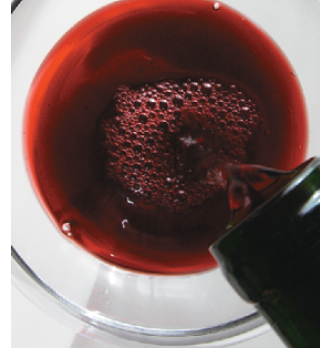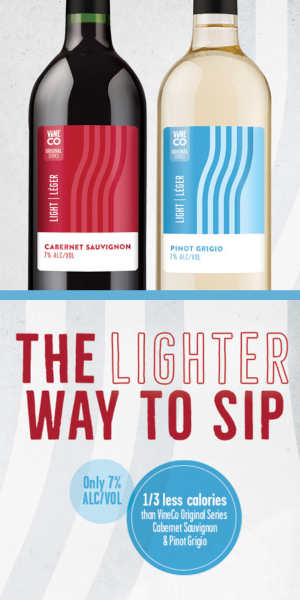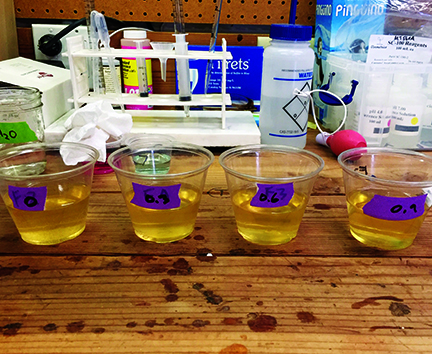
Oxidation gets a lot of attention in winemaking — and it should! WineMaker magazine has covered oxidation issues from several different angles over the past few years. While some presence of oxygen in wine contributes positive effects, most of the time the home winemaker is excluding oxygen to avoid the browning, aldehyde formation, and spoilage that may result from oxidation.
In chemistry, though, oxidation is just half the story! In a yin-and-yang condition that is learned by every chemistry student, any oxidation reaction is more properly characterized as a “half reaction.” That is because the other half reaction, allowing the entire process to occur, is the reduction half reaction. When I used to work in environmental chemistry, it was commonly noted that to get something clean you have to get something else dirty. In similar fashion, to get something oxidized, something else must be reduced.
To provide a basis for the further discussion of reduction in wine, we need to delve into basic chemistry a bit. The pair of half-reactions that make up an oxidation-reduction complete reaction (abbreviated redox) are all about the exchange of electrons. Those negatively charged subatomic particles that we imagine whizzing around the nucleus of every atom arrange themselves in only certain favored configurations on any given element. When the number of electrons associated with any given atom changes, oxidation or reduction is occurring.
When an element is in its native state with no positive or negative charge, there are exactly as many electrons associated with it as it has positive protons. The number of protons is called the atomic number for the element and it is the index number for positioning each element in the periodic table. For instance, copper, with atomic number 29, always has 29 protons in the nucleus; that is what it means to be copper. (It is usually described as having 35 neutrons as well, but that number actually varies a bit with the different “isotopes” of copper. Fortunately, we do not need to get any further into isotopes to discuss redox!) What all of this does mean for redox is that having exactly the same number of electrons as protons, 29 in the case of copper, puts the element in what is called the “zero oxidation state.” It is the pure element in its native form with no net charge; it is neither a positive ion (cation) nor a negative ion (anion). (Speaking of copper, it must be noted that while it can be helpful in treating wine to remove sulfides as discussed later, excess copper can cause oxidative damage.)
Beginning with the zero oxidation state, we can define oxidation and reduction. When an atom loses some of its electrons, that is oxidation. If an atom gains electrons, that is reduction. Because these principles are so fundamental to chemistry, but also inherently difficult to keep straight in the student’s head, several mnemonic devices have been developed to help. Decades ago when I was studying chemistry, we used a lion to help us pass the test. Keeping in mind the letters LEO GER (like a lion roaring), we knew “Loss of Electrons is Oxidation, Gain of Electrons is Reduction.” Two of my young colleagues at The Beverage People have told me that a different sequence is taught now, at least at two campuses of the University of California. Maybe acknowledging the oil fields in California’s Central Valley, they are taught OIL RIG. “Oxidation Is Loss and Reduction Is Gain.” If either of those works for you, keep it in mind to help get through the rest of this column!
To see how this plays out, let’s consider a simplified representation of what happens to the sulfur in a sulfur disk or wick when you burn it in an oak wine barrel in the presence of air (which is about 21% oxygen). As noted earlier, electrons arrange themselves (in “orbits”) in only certain preferred configurations. That means any element will have only certain oxidation states available to it. An element will not be stable with just any random number of electrons. Of course, as a pure element, oxygen is in the zero state. Otherwise, in compounds, it is most commonly in the -2 oxidation state (with two extra electrons) and is occasionally found in -1 (with just one extra electron). It does not have other stable states. Sulfur has several stable oxidation states. It may be found as -2, -1, and zero, like oxygen, or in +1, +2, +3, +4, +5, or +6 oxidation states. (That’s part of what makes sulfur chemistry so complex and makes sulfur in wine such an interesting subject.) We can depict our simplified reaction as:
S + (O2) → SO2
(Note that I have shown sulfur here as though it is just a single atom. In reality, elemental sulfur organizes itself into cyclic octatomic molecules of formula S8. Since each of the eight remains at the zero oxidation state, a single S can stand in for our redox example here.)
With the elemental sulfur in the disk or wick at the zero oxidation state, it has exactly as many electrons associated with each atom as it has protons: 16 of each. Meanwhile, the oxygen molecule listed is in its pure elemental state and is therefore also at a zero oxidation state. It has all of its standard complement of eight electrons matching its eight protons. (Any free oxygen atom in nature combines with another to produce the oxygen compound we are familiar with, O2.)
In the reaction product, SO2, the sulfur has changed to the +4 oxidation state by losing four electrons; loss of electrons is oxidation and this sulfur atom has been oxidized. That is the oxidation half reaction:
S0 → S+4
Since there must be a balancing reduction half reaction, we note that in the reaction product both oxygens are now at the -2 oxidation state. Each oxygen atom has gained two electrons in going there from the zero elemental state. Gain of electrons is reduction and that oxygen has been reduced:
O0 → O-2
Reduction wine phenomena are often associated with sulfur. The simplest reduced sulfur compound found in wine is hydrogen sulfide, H2S. We know that is reduced sulfur because hydrogen is generally either in the zero state, H, or is +1. With two of them at +1, the sulfur is at -2. It has gained two electrons and therefore been reduced. Hydrogen sulfide stinks, often described as smelling like rotten eggs. It is part of a larger class called volatile reduced sulfur compounds, or VRS, all of which stink and all contain reduced sulfur atoms. Therein lies the scourge of reduction chemistry in wine!
As for the presence of hydrogen sulfide in wine, authors site up to four possible sources:
• Enzymatic reduction of inorganic oxidized sulfur compounds such as sulfate and sulfite.
• Metabolic predisposition of some yeast strains to produce hydrogen sulfide as part of their normal
metabolic processes.
• Residue of elemental sulfur dust from vineyard application or residual sulfur in a barrel from an incompletely burned disk or wick.
• Degradation of protein components (amino acids) by yeast that releases reduced sulfur.
Enzymatic reduction of inorganic sulfur compounds occurs in some water wells in the presence of sulfur reducing bacteria. In most winemaking situations, those same bacteria should not survive under wine conditions of alcohol, acid, pH, and sulfites. As always, the home winemaker should practice careful sanitation to minimize the introduction of spoilage bacteria and should judiciously apply sulfites to inhibit their possible growth.
Yeast strains vary in their tendency to produce hydrogen sulfide. Manufacturers and suppliers will often list these tendencies in yeast charts or tables. My recommendation is to avoid those with a high potential for hydrogen sulfide, even if you like other characteristics of that yeast strain. There is almost always another choice with similar characteristics but without that tendency. It is just too risky to give yourself that additional burden in trying to make great wine. This potential problem is so well recognized that an entire line of yeasts has been grown to combat it. It started with a strain first isolated from a Lambrusco fermentation in Italy, strain UCD932. That strain was found to be essentially incapable of producing hydrogen sulfide. Using conventional cross-breeding techniques (no GMO), a Canadian company called Renaissance Yeast has developed several strains for different kinds of wine that retain the UCD932 resistance to producing VRS (the yeasts are distributed by Gusmer Enterprises in the US and Bosagrape in Canada). Decide the characteristics you want out of your yeast, then choose a strain that does not have a high tendency to produce VRS.
Also worth your attention, especially if you grow your own grapes, is the problem of sulfur applied in the vineyard for mildew control too late in the season. Such applications may bring elemental sulfur directly to your fermentation where it has a couple of negative effects. It provides a source of sulfur that can be readily reduced from the zero state to the -2 stinky state. It also tends to inhibit microorganisms — that is how it achieves mildew control — and therefore may stress your yeast. Stressed yeast is more likely to produce VRS. Management must be entirely by prevention. You cannot wash your grapes because excess water will dilute the sugar and acid you are working hard to achieve. That means you must stop applying sulfur early enough for it to dissipate naturally. A common recommendation, and one I follow, is to discontinue sulfur applications at veraison (the coloring up of the grapes). That should leave about five weeks for sulfur to fade away before harvest. If you must continue battling mildew, consider products like Stylet oil or Elevate that do not contain sulfur. Equally important, do not use a barrel that has elemental sulfur in it from a disk or wick. If you have burned one of those in your barrel, carefully examine it with a flashlight to make sure none has dripped. If it has, wash out all residue or it may cause the same problems as excessive vineyard sulfur dust.
The final source to manage is also the most common. It is degradation of protein components (amino acids) by the yeast that release reduced sulfur. In its normal metabolism, wine yeast uses nitrogen that it gets from ammonia or amino acids in its life processes. If available, the nitrogen will be sourced from amino acids that do not themselves contain sulfur. However, if supply is short, amino acids like cysteine and methionine, which do contain sulfur, will be degraded. The byproduct is VRS. The solution is to make sure you have met the nutrition requirements of your yeast. Follow the yeast manufacturer’s guidelines to be sure you have adequate natural nitrogen present or supplement with complex nutrients like Superfood or Fermaid, possibly in conjunction with simple ammonia nitrogen from diammonium phosphate (DAP). Protein degradation that releases VRS may also occur when lees accumulate under anaerobic conditions during aging and undergo autolysis. If you wish to age on the lees — the practice the French call sur lie — make sure you also follow the French practice of stirring those lees — bâtonnage — to prevent VRS development.
If, in spite of prevention efforts, you do detect hydrogen sulfide in your wine, treat it promptly. For a low level of VRS, splash racking and the resulting aeration may drive off the offending aromas. For a higher level or if racking does not work, there are other products available. Lallemand makes a proprietary formulation of inactivated yeast (yeast hulls) they call Reduless that is naturally rich in copper. Used in wine at a rate of 10-15 g/hl, it combines with hydrogen sulfide and drops out as copper sulfide. Racking after 72 hours should clear up the wine. A companion product, Noblesse, is a yeast derivative nutrient that has its sulfite reducing enzyme (sulfite reductase) inactivated. It may help prevent a return of a VRS problem in the treated wine.
More directly, the problem can be treated with copper 2+ (cupric) ion. The reaction is:
Cu2+ + S2- → CuS
The reaction product, copper sulfide, is insoluble and will drop to the bottom where you can leave it behind when racking off. Note that this is not a redox reaction; the copper stays at 2+ and the sulfur stays at 2-. They combine and precipitate. Exercise caution with this treatment as copper is a toxic metal. The US Tax and Trade Bureau (TTB) allows commercial wineries to use up to 6 ppm (parts per million) of copper in treating wine, but the maximum allowed residual level is just 0.5 ppm. If you use a 1% solution of copper sulfate to treat your wine, you can add up to 0.75 mL per gallon (3.8 L) of wine to meet a 0.5 ppm maximum addition. If you must treat with more copper solution to clean up VRS, do so only if you have a wine testing laboratory available to verify a final wine concentration of less than 0.5 ppm. Treatment with yeast hulls may remove excess copper from treated wine.
If I have given you new concerns about reduction in your wine, do not let them overwhelm your attention to oxidation. By all means, avoid excess vineyard sulfur, provide adequate nutrition, and stir any lees. But I have encountered many more homemade wines spoiled by oxidation than reduction. Unfortunately, that brown, nutty, aldehyde-rich oxidized wine cannot be easily corrected. On the other hand, treated promptly, a rotten-egg stinky reduced wine can be cleared up completely with no lingering effects.






